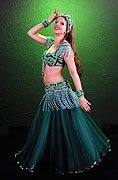Dance like the big stars
During the past years I have started to analyse the dance styles of the big star dancers in the Middle East and to offer my knowledge about the subject in workshops that are quite popular. Recently I have been asked to tell about my motivation and philosophy for these classes, so I this is what I would like to do in the following article.
What can we learn from the stars?
We always learn a certain dance style through imitation.
Even if we dance"
freestyle" in a club, we are unconsciously or consciously
influenced by what we see our friends dancing stars on MTV doing.
Our first inspirations for Oriental dance are usually our techers who show and
explain the movements – which is a big advantage of course, because that
way we can ask them if we don’t understand something or they can correct
us to improve our movements.
When studying the star dancers we mostly depend on videos because even the dancers in Egypt or Lebanon who are still active only come to the West rarely to teach. We copy their dance moves from what we see on the screen.
It takes some experience to properly analyze the execution of a movement, where in the body it is starting etc. And camera angles are not always useful – in fact it’s often quite frustrating if the camera is on the dancer’ s face while she is doing a hip shimmy... There’s also a certain danger that one might copy bad habits (many dancers are very one-sided) or mannersisms that will look rather strange on one-self.
Basically the intention is not to become an exact copy of a certain dancer but to extend one’s own repertoire.
How to analyze
For me the most important thing to get the style
of a dancer are the arm and hand movements. Because through these
we express our personality. One can recognize most dancers even
on bad photos by the way they hold their arms.
After this I study its use of hip and torso movements, steps and turns, use of
stage space, how she dances accents rsp. taqsims, facial expression, which accessoires
she uses and how, and everything else that belongs to a dance performance. This
is of course quite time consuming; I often watch the same few minutes of dance
a dozens times in order to analyze certain moves and cominations.
It is also very useful to know the social background of a dancer. What kind of family is she from, how does she live, what is her artistic vision, etc....
Instruction
For classes I arrange a varied selection of typical movements of the respective dancer. Then I drill them with the students, so that their bodies get accustomed with the new movements. Sometimes I also teach a choreography, that way the movements are automatically repeated many times.
Usually one notices quite soon after some practice, which movements of a certain dancer are appropriate for oneself – and will then incorporate them in the own repertoire - while others will not fit that well and therefore will be avoided.
 MEISSOUN in the style of Amani
MEISSOUN in the style of Amani
Star styles on stage
From time to time I present dance numbers on stage that are held completely in the style of a certain dancers – along with music and costuming.This is always a special challenge for me and preparations include that I will watch this dancer’s videos again for hours to get into their mood. It certainly helps that I have a talent for acting that I can use for those dances.
These dance numbers are always choreographed, because if I would improvise, would be automatically „myself“ again. Sometimes I combine the movements from the repertoire of the respective dancer freely, sometimes I follow well-known interpretations of the music by the dancer herself, e.g. Tamra Henna, that was performed by Naima Akef in the film of the same name, or Tahtill Shibbak, one of the favourite songs of Dina, that she uses in nearly all of her shows.
 MEISSOUN in the style of Dina
MEISSOUN in the style of Dina
What is typical for which dancer?
Here are some examples that I have analyzed- Dina – a lot of tension in the whole body as well as in arms and legs, many movements led by the torso muscles, interesting accents, a lot of expression
- Amani - travelling turns, soft flowing arms, a lot of dynamic, high heel shoes
- Suheir Zaki - turns led by the shoulder, many arm positions in the right angle, the "Suheir Zaki Step" of course : -)
- Asena - elegant walk, reserved attitude, wide Arm movements
 MEISSOUN in the style of Suheir Zaki
MEISSOUN in the style of Suheir Zaki